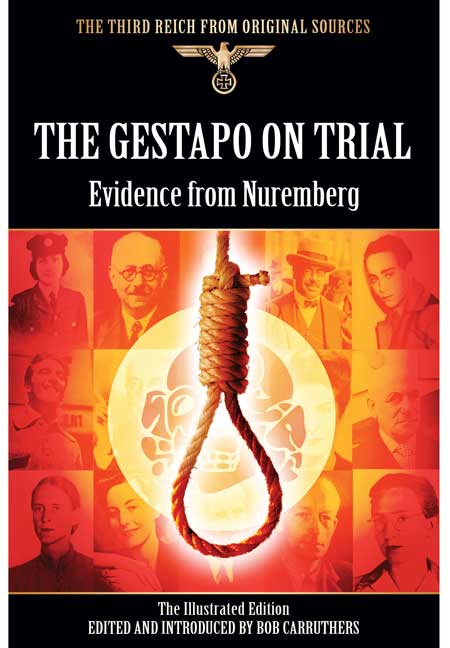Gestapo on Trial (Paperback)
(click here for international delivery rates)
Need a currency converter? Check XE.com for live rates
| Other formats available | Price |
|---|---|
| Gestapo on Trial ePub (5.1 MB) Add to Basket | £6.99 |
The Nuremberg Trials were held by the four victorious Allied forces of Great Britain, the USA, France and the USSR in the Palace of Justice, Nuremberg from November 1945 to October 1946. Famous for prosecuting the major German war criminals, they also tried the various groups and organisations that were at the heart of Nazi Germany.
This fascinating volume is concerned with the trial of the Gestapo and includes all the testimony from the Nuremberg Trials regarding this organisation, including the original indictment, the criminal case put forward for the Gestapo, the closing speeches by the prosecution and defence and the final judgment. The book also includes evidence regarding the S.D. and the defendant Ernst Kaltenbrunner, who was Obergruppenführer and General der Polizei und Waffen-SS.
The witnesses called for the trial of the Gestapo and the SD include among others, Karl Hoffmann who was head of the Gestapo in Denmark; Dr. Werner Best, head of Department 1 of the Gestapo, who was relied on by Himmler and Heydrich to develop the legalities of their actions against the enemies of the state and the Jewish problem; Rolf-Heinz Hoeppner, who was responsible for the deportation of Jews and Poles and the settlement of ethnic Germans in Wartheland; and Dieter Wisliceny who participated in the ghettoisation and liquidation of many Jewish communities in Greece, Hungary and Slovakia.
The decision by Allied prosecutors at Nuremberg to include Organisations as well as individuals in their indictment was not uncontroversial, even for 1945. What they sought to do was to demonstrate quite clearly the criminal nature of the regime and at the same time facilitate trials involving subordinates by pursuing the Organisations for which they worked. But many jurists, troubled by the implications of collective responsibility and retrospective prosecution, were opposed. In this volume, Bob Carruthers presents all those records from the International Military Tribunal relevant to the case against one such Organisation, the Gestapo, thereby enabling readers to judge for themselves just how far the experiment actually succeeded.
Stephanie A. Jefford
Following these proceedings takes us into the darkest recesses of the human mind, as witnesses are heard, and documents produced by prosecution and defence relating to all four Counts of the Indictment, including War Crimes and Crimes Against Humanity. Witnesses include the Commander of Einsatzgruppe D, Otto Ohlendorf (pp 80-116), Eichmann aide Dieter Wisliceny (116-132) and Gestapo official and ideologist Dr Werner Best (147-175). Wisliceny's testimony provides important evidence about the Holocaust (119-120) and Eichmann's methods (119), together with some disturbing insights into his personality (see esp. 120-121; 124 and 131). Was Best's 1941 textbook on the German police (in which "Destiny" takes precedence over "Law") a warning to the Leadership, as he claimed in court, or portentous Nazi rhetoric? Did the organisational infrastructures of the Gestapo, SD and so-called Einsatz groups exist in watertight compartments, as the defence claimed, or were they inextricably linked? These and other questions were what had to be addressed by a collection of the finest forensic minds available to the Allied powers at that time (amongst them the legendary Whitney Harris), pitted against a capable defence prepared to fight for every inch of ground.
The first volume of its kind to focus specifically on proceedings against the Gestapo, it also constitutes a valuable historical record.
In 370 large and tightly-printed pages, this book opens Western eyes to the Reich and it monstrous leaders, as it walks through the Nuremberg trial of the Gestapo.
My Hobby Info














